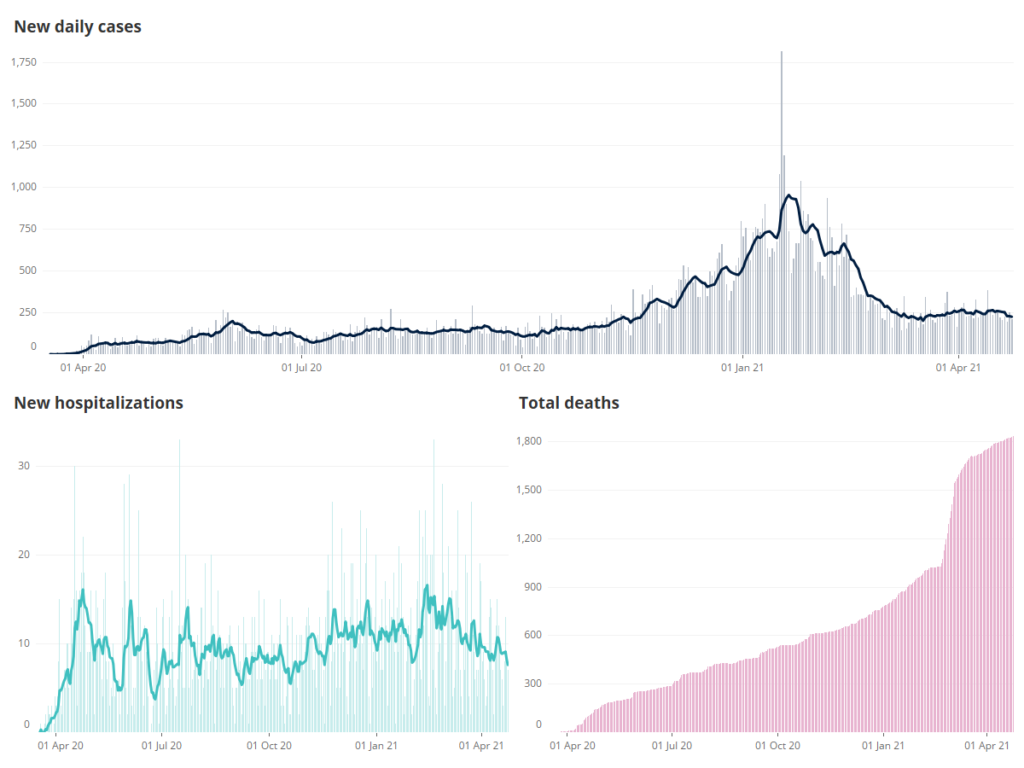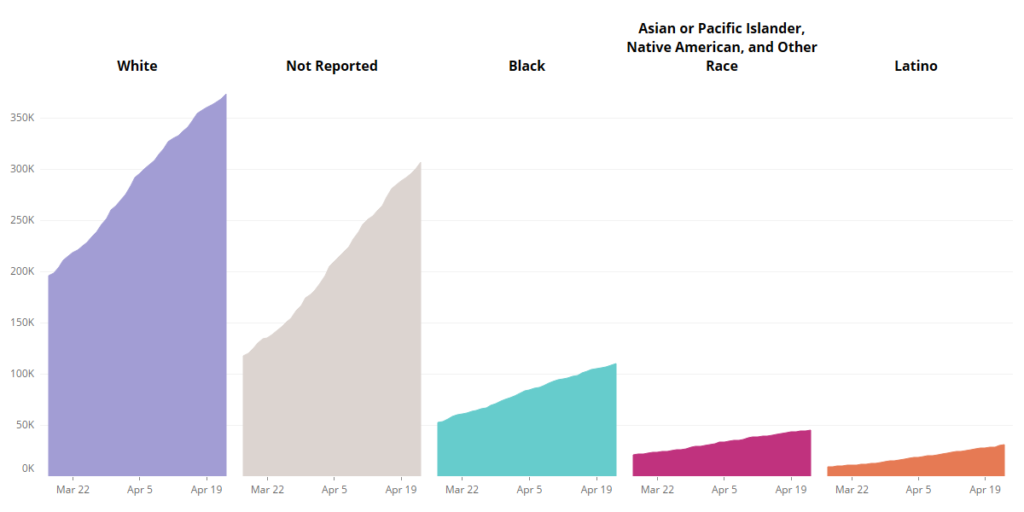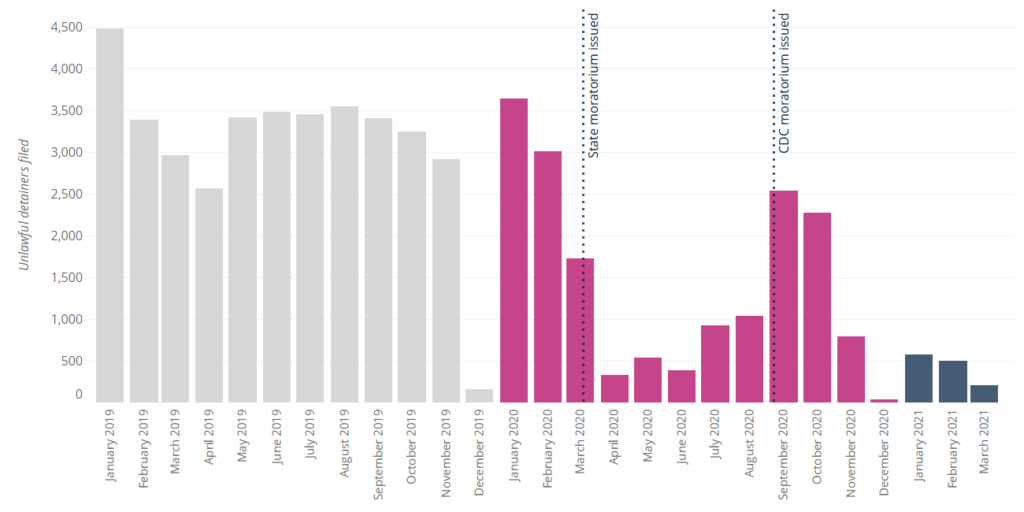02 Background
Takeaways from Phase 1 Report
In June 2020, HousingForward Virginia and the Virginia Housing Alliance released the Phase 1 Report of their “Impact of the COVID-19 Pandemic on Richmond’s Nonprofit Housing Providers and Clients” research initiative. Using in-depth interviews with the leaders of more than twenty housing organizations in the region, they found:
- Fair confidence that providers could weather the initial months of the pandemic via changes to workflow, increased donations, and federal payroll assistance.
- Much lower confidence about long-term financial resiliency if the pandemic (and subsequent economic downturn) lasted later into 2020 or beyond.
- Unprecedented collaboration among homelessess service providers to swiftly deliver temporary shelter and resources to unhoused persons.
- Significant concern that expiring eviction moratoriums will create a “crisis after the crisis” that providers do not have the planning or funding to adequately address.
- Stress and burnout were becoming problems for frontline staff, especially among homelessness providers. Back-end staff alike were beginning to experience fatigue and mental health challenges.
These takeaways served as the background context for the Phase 2 surveys and interviews conducted for this report.
The Evolving Pandemic
Cases are finally declining, but only after unprecedented surges.
When providers were first interviewed in late April of 2020, Virginia’s daily COVID-19 case count was approaching 900. In early June, our first peak topped at 1,100 cases per day before the state began its “Phase 2” reopening plan. Despite continued precautions, cases rose again in late summer, plateauing near 1,000 new infections per day into the fall as the public began experiencing pandemic fatigue.
Then, as the holiday season approached, cases started to rise exponentially before peaking around 5,000 per day at the New Year. Total confirmed infections have steadily declined since, but remain close to 1,000 per day statewide, and 250 in the Richmond region, as of mid-April. This number would have shocked many a year ago, but is part of daily life today. Simply put: COVID-19 is still far from over.
This prolonged pandemic has tested our housing providers more than they could have ever expected over the past year. Immediate feelings of stress, anxiety, and uncertainty still remain in some form for many, and are now paired with months of fatigue and burnout. Numerous organizations have also dealt with serious illnesses and deaths for themselves, colleagues, clients, friends, and family. Recovery will not be easy.
FIGURE NUMBER 2.1
COVID-19 cases, hospitalizations, and deaths in the Richmond region
As of today, more than 200 test positive on a daily basis, and more than 1,800 have passed away since the beginning of the pandemic.

Notes: Data includes all localities in the Richmond, Virginia MSA. Dark lines show 7-day moving averages. Current through April 23, 2021. High increase in deaths in March 2021 due to bulk processing of death certificates from holiday season.
The vaccine rollout offers light at the end of the tunnel.
The first doses of the COVID-19 vaccine reached Virginia in mid-December 2020. These were administered to persons in “Phase 1a,” which included healthcare personnel and residents of long-term care facilities. By early January, many other essential workers and vulnerable populations started to receive vaccinations under “Phase 1b.” Of note, these groups included:
- Persons living in homeless shelters,
- Persons age 65 or older,
- Adults with certain health conditions, and
- Workers and volunteers at homeless shelters
Many clients and staff of providers in the Richmond area were able to receive the vaccine during this phase. The Daily Planet alone provided more than 3,800 doses to persons experiencing homelessness and shelter workers by the end of March.
FIGURE NUMBER 2.2
Daily COVID-19 vaccine doses administered in the Richmond region
The number of vaccine shots given out in the region has increased nearly ten-fold since rollout began in December.

Notes: Data includes all localities in the Richmond, Virginia MSA. Dark line shows 7-day moving averages. Current through April 23, 2021.
Expansion into “Phase 1c” due to increased vaccine production and delivery has now greatly expanded eligibility for other essential workers, including persons in housing and construction. Virginia will move into “Phase 2” on April 18, 2021, which will allow anyone 16 and older to schedule a vaccine appointment.
This accelerated vaccine rollout now means that more than 3.2 million Virginians have received at least one dose, and nearly 2 million are fully vaccinated. According to the Richmond and Henrico Health Districts, 33% of all people in Richmond and Henrico have received at least one dose of the COVID-19 vaccine, and 18% of residents in Richmond and Henrico have been fully vaccinated, as of April 15, 2021.
However, public health officials have struggled to distribute the vaccine equitably among minority communities. Across the state, the vaccination rate for white persons is about 23 per 100, but less than 16 per 100 for Black persons. In the Richmond region, roughly twice as many vaccine doses have gone to white individuals than to minorities, although many records have incomplete data for race and ethnicity.
FIGURE NUMBER 2.3
Cumulative COVID-19 vaccine doses administered by race and ethnicity in the Richmond region
Despite incomplete data, the difference between white and non-white vaccination rates highlights ongoing health disparities.

Notes: Data includes all localities in the Richmond, Virginia MSA. Race and ethnicity reporting for vaccine doses began March 17, 2021. Current through April 23, 2021.
Most people have avoided disaster, but the reprieve may not be permanent.
Thanks to federal stimulus relief, eviction moratoriums, and other measures, many low-income households have avoided serious financial crises. However, that hasn’t been the case for everyone, and the worst may still be yet to come.
The good news:
Extra cash assistance worked.
Direct stimulus payments to individuals and increased unemployment insurance levels have served as a critical lifeline for many, especially workers with lost jobs or reduced hours. Among CARES Act stimulus payment recipients with incomes below $75,000:
- 84% used the money on food,
- 68% used the money on utilities,
- 64% used the money on household supplies, and
- 44% used the money on rent.
Eviction moratoriums have kept people in their homes.
While the enabling authority and subsequent guidance of these stoppages have resulted in various challenges, such policy measures have prevented massive waves of households being evicted due to nonpayment of rent. Most importantly, researchers determined these bans were effective at stopping the spread of COVID-19. According to a recent study from Johns Hopkins Medicine:
“People who are evicted or who live in a household that hosts evictees have 1.5 to 2.5 times more risk of being infected with SARS-CoV-2 than if the eviction bans were in place . . . [and] that without eviction bans, the risk of SARS-CoV-2 infection would rise for all residents of a city, not just those who are evicted.”
Nande, A., Sheen, J., Walters, E.L. et al. “The effect of eviction moratoria on the transmission of SARS-CoV-2.” Nature Communications 12, 2274 (2021).
Rent and mortgage assistance programs are increasing their capacities.
Using federal relief dollars and additional state allocations, the Virginia Rent and Mortgage Relief Program (now Rent Relief Program) started to distribute assistance to households affected by the pandemic in June 2020. The program has been streamlined since its inception, and now includes a landlord-initiated component. Nearly 30,000 households across the state have been served since the program began. (More information on the RRP is provided in the next section.)
The bad news:
Many Virginians are one step away from a housing crisis.
According to the latest Census Bureau Housing Pulse Survey, almost 1.5 million adults in Virginia—about one in four—still find it somewhat or very difficult to pay for usual household expenses. Over 200,000 Virginians are behind on their rent or mortgage payments and have little confidence they can pay next month on time. And more than 145,000 say that eviction or foreclosure notices are “very likely” or “somewhat” likely in the next two months.
Eviction moratoriums haven’t actually stopped all evictions.
The initial Virginia State Supreme Court order to shut down nearly all court proceedings, including unlawful detainers, came down on March 17, 2020. Since then, the legal landscape has remained fluid and complex. This initial order was extended several times until May, when courts received guidance on how to hear cases if elected. Some courts started to hear all eviction cases at this point. By the end of June, VSC let state protections expire, citing the rollout of DHCD’s new rent relief program. In the Richmond region, eviction filings began noticeably increasing in July.
At the beginning of September, the Centers for Disease Control announced a national moratorium on evictions for households who affirm their inability to pay because of pandemic-related reasons. While the implementation of this moratorium was being sorted out during September and October, landlords filed more than 4,000 unlawful detainers in the region.
Since November, total eviction filings remain relatively low. However, several major issues remain with the CDC order and subsequent language in the most recent state budget aimed at reducing evictions. Namely, the CDC moratorium only applies to “nonpayment” cases, and does not address “de facto” evictions that occur when a landlord refuses to renew the tenant’s lease. According to advocates and legal aid attorneys, these non-renewals are increasing in frequency.
Finally, despite the best efforts of state and local agencies, the initial rollout of emergency rental assistance was slow and difficult. Applications took very long to process after entirely new programs were created, and money flowed at a much slower rate than needed. While these funds are getting deployed much more quickly and efficiently today, exceptions remain: for example, landlords may proceed with eviction proceedings if a tenant’s assistance agreement is not fully completed within 45 days.
FIGURE NUMBER 2.4
Eviction filings didn’t end during the pandemic.
Despite state and federal moratoriums, landlords in the Richmond region have filed over 10,000 eviction notices in courts since April 2020.

Notes: Includes all unlawful detainers filed throughout seventeen general district courts in the Richmond, Virginia MSA. Records have not been fully deduplicated; therefore, there may be multiple unlawful detainers for the same tenant.
Renters owe billions of dollars in back rent.
In the Richmond region, one in four renters pay more than half their income on rent. Without significant increases to rental assistance programs and flexible payback plans, thousands of renters face a looming crisis when the eviction moratorium expires due to high levels of unpaid rent.
While there is no accurate measure of total missed payment amounts that renters owe, national estimates land between $8.4 billion and $52.6 billion, depending on how calculations account for certain stimulus measures and other factors. According to the National Council of State Housing Agencies, the estimated total arrearage for renters across Virginia is $578 million to $802 million. If roughly accurate, this amount is within range of the current funding Virginia has allocated for emergency rental assistance.
Federal and State Responses
March 2020: The CARES Act passes; first eviction moratoriums appear
Congress passed the first federal relief package on March 27, 2020. The $2.2 trillion “Coronavirus Aid, Relief, and Economic Security” (CARES) Act included direct stimulus payments to Americans, provided additional unemployment assistance, created the Payroll Protection Program (PPP), doled out aid for state and local governments, and created many other measures meant to keep the economy afloat while the country began attempts to mitigate the spread of COVID-19.
Virginia received over $3.3 billion in aid from the CARES Act to cover costs incurred by the pandemic and subsequent economic downturn. This included $145 million in housing aid via additional CDBG, ESG, and HOPWA dollars. Half went to the state to distribute to non-entitlement communities, and the remainder flowed directly to local governments. This total was $50 million more than the FY2020 annual allocations for these programs. Chesterfield, Henrico, and Richmond received $13.7 million, while Colonial Heights, Hopewell, and Petersburg received $978,000.
The CARES Act also established an initial moratorium on evictions that applied to rental homes with federal assistance (e.g. public housing and HUD-financed multifamily properties), as well as foreclosures in owner-occupied homes with federally-backed mortgages.
Meanwhile, the Virginia Supreme Court placed a temporary hold on eviction proceedings across the state on March 16, 2021. This action formalized similar measures taken by some local court systems, including Richmond. The original order was valid for only three weeks; it was subsequently extended on several occasions until the later CDC moratorium was published.
Simultaneously, the State Corporation Commission also ordered utility service disconnections temporarily suspended for an initial 60 days. This order was extended on several occasions throughout 2020.
June 2020: Virginia launches Rent and Mortgage Relief Program
Near the end of June 2020, the Virginia Department of Housing and Community Development created the Virginia Rent and Mortgage Relief program. The program was established to provide direct assistance to households facing eviction or foreclosure due to pandemic-related loss of income. Local and regional nonprofit partners across the state were recruited to take applications and distribute the assistance. Funding was initially provided with $50 million in CARES Act dollars.
In late 2020, the program was renamed to the Rent Relief Program (RRP) and expanded to include a landlord-initiated component administered by Virginia Housing to help property owners make assistance more readily available to tenants in need. This shift was necessary to increase the scale of funding: instead of individual renters applying, assistance could now be aggregated through property managers who could familiarize themselves with the program and accelerate disbursements.
Since then, the RRP has disbursed $138.7 million to 28,960 unique households. The average amount of assistance is $4,789. According to DHCD, the program has “prevented more than 33,000 evictions.” Nearly three in four (73%) of approved applicants had incomes at or below 30% AMI, and Black households accounted for over half (52%) of those served. The program currently disburses about $10 million in assistance per week. (Figures as of March 24, 2021.)
August 2020: General Assembly meets for Special Session
To address both COVID-19 and calls for racial justice legislation in the wake of the killing of George Floyd, the General Assembly convened for a special session on August 18, 2020. After more than a month of negotiations, lawmakers approved a revised state budget, which set aside $254 million to address pandemic-related housing needs. This included funding for emergency housing, rent relief (via the RRP), utility relief, and legal aid for persons facing eviction.
September 2020: CDC announces national eviction moratorium
At the beginning of September, The Centers for Disease Control issued a national moratorium on evictions as a measure to prevent further spread of COVID-19. To be eligible for this protection, renters must be below certain income thresholds, affirm their hardship is due to COVID-19, and affirm they are likely to become homeless if evicted. After this CDC moratorium was announced, the Virginia Supreme Court decided to not renew its previous halt on eviction proceedings.
The moratorium was originally effective through the end of 2020, but was briefly extended several times in December and January. On March 29, 2021, the Biden administration extended this moratorium through the end of June. However, the directive was not amended to address legal challenges in several states that have sought to nullify the order.
November 2020: Governor signs revised state budget
On November 18, 2020, Governor Northam signed a revised version of the state budget. Amendments were made due to “previously unannounced” CARES Act funds to state. These changes included an additional $12 million to expand RRP and $100 million for utility assistance. It also established a new moratorium on utility disconnections (to renew prior SCC action that had expired) and strengthened the CDC eviction moratorium at the state level through the end of 2020 by covering all non-payment of rent unlawful detainers.
December 2020: Second federal relief bill passes Congress
President Trump signed the $2.3 trillion Consolidated Appropriations Act on December 27, 2020. The bill combined a $1.4 trillion omnibus spending package with another $900 billion in COVID-specific relief, including another round of direct stimulus payments to Americans, $25 billion in emergency rental and utility assistance, and additional Payroll Protection Program (PPP) funds to allow certain businesses to re-apply for a second loan.
The bill also provided an extension of the deadline for state and local governments to use CARES Act dollars (although it did not provide additional state and local relief), as well as an extension of the CDC eviction moratorium until January 31, 2021. Also of note, the bill established a permanent “4% floor” for Low-income Housing Tax Credits which will increase the effectiveness of the program.
In Virginia, an additional $567 million of rental assistance dollars flowed into RRP and to certain localities who stood up their own programs. Chesterfield County provided $10 million to ACTS in February 2021 for the Chesterfield Emergency Rent and Utility Assistance program.
March 2021: American Rescue Plan passes Congress
The $1.9 trillion American Rescue Plan was signed by President Biden on March 11, 2021. The bill continues and expands efforts from the previous two major relief packages, including: additional state and local aid, another round of direct stimulus payments, $27.4 billion in emergency rental assistance, $5 billion for homelessness assistance, and almost $10 billion for a Homeowner Assistance Fund.
In total, Virginia is expected to receive more than $6.8 billion from the ARP. The state expects an estimated $450 million from American Recovery Plan to be used for rental assistance; the deadline to spend those funds is September 30, 2025.